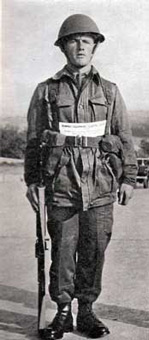 From the outset, the Pattern was design for use in two primary modes, Fighting Order and Marching Order and these terms were used in the first two editions of the Fitting Instructions. The December 1957 issue of Soldier magazine, the Army’s official organ, reproduced the photograph at left, when Patt. ’58 was at its trials stage. The soldier has a label - obviously placed there by “authority” - which clearly states Combat Equipment Fighting Order.
From the outset, the Pattern was design for use in two primary modes, Fighting Order and Marching Order and these terms were used in the first two editions of the Fitting Instructions. The December 1957 issue of Soldier magazine, the Army’s official organ, reproduced the photograph at left, when Patt. ’58 was at its trials stage. The soldier has a label - obviously placed there by “authority” - which clearly states Combat Equipment Fighting Order.
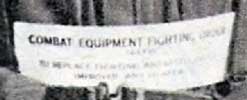 The initials C.E.F.O. and C.E.M.O. were not used in the 1959 and 1965 Fitting Instructions. First use noted is in 1980, in Mike Chappell’s British Infantry Equipments 1908-80, published that year. The author, an ex career soldier who retired as a Warrant Officer, gives the initials as Combat Equipment. Surely we can depend on a W.O. to get it right? The 1990 instructions, contained in the Fieldcraft handbook give the full initials and renders the first two as Complete Equipment.
The initials C.E.F.O. and C.E.M.O. were not used in the 1959 and 1965 Fitting Instructions. First use noted is in 1980, in Mike Chappell’s British Infantry Equipments 1908-80, published that year. The author, an ex career soldier who retired as a Warrant Officer, gives the initials as Combat Equipment. Surely we can depend on a W.O. to get it right? The 1990 instructions, contained in the Fieldcraft handbook give the full initials and renders the first two as Complete Equipment.
Opinion here was (but is no longer!) divided as to which is correct! For my part, sufficient examples exist for me to distrust the Army’s ability to get its nomenclatures correct and I prefer to trust Soldier magazine and an Warrant Officer. Two of us feel that, in writing the Fieldcraft pamphlet, MoD clerks saw “C.E.”, but only recalled “C.E.S.” These initials are a long-standing, standard Army abbreviation for Complete Equipment Schedule, e.g. connection with radio equipment, or what was used with a machine gun, etc..
I am indebted to reader Richard Aixill, who found List of Ministry of Defence (MOD) acronyms and abbreviations, 2006 edition here:-
https://www.gov.uk/government/publications/mod-acronyms-and-abbreviations. On p.70, without full-stops, which is the regrettable and lazy Modern Way, it lists
CEFO Combat Equipment Fighting Order and
CEMO Combat Equipment Marching Order
It rather looks as though the single “CU” entry, in this document, needs a second entry. To borrow what was originally a printer’s technical term, the 1990 Fieldcraft manual was a CU – a Cock Up!!! Finally, on P.71, it has a listing for “CES”, now grown to three uses, only one of which is “Complete Equipment Schedule”!! Small wonder the MoD Minions got confused.
Notwithstanding, C.E.M.O. and C.E.F.O. are the modern terms for what had once been Field Service Marching Order (F.S.M.O.) and Battle Order, in the days of Patt. ’37 W.E. This older Pattern served alongside Pattern 1958 W.E., appearing in full until 1985. Upon the introduction of Patt. 1990 P.L.C.E. (Personal Load Carrying Equipment), Patt. ’58 was relegated to a secondary role and Patt. ’37 W.E. finally disappeared from Section CN in COSAs.
Patt. ’58 was worn in a variety of ways, the simplest of which was a Belt Order with Water bottle, sometimes with one Ammunition pouch, without the Yoke. The Pouches, rear were designed for quick release from the belt, using Keyways, but in a way not envisaged when the Keyway first appeared in the Trials Patterns of Cavalry W.E.. In consequence, a Yoke supported rig, with both Pouches, ammunition, a Carrier, water bottle and sometimes the Carrier, cape was also worn. Once “officer” type items had been added, further permutations were possible.
Another range of items was added for the specific use of the Special Air Service (S.A.S.) and, no, these were not dyed black! However, they did have special supporting Braces, which allowed for wearing the old-fashioned Bergen “A” frame rucksack, commonly employed by the S.A.S. As this had a lumbar support, at the level of the waist, these S.A.S. Pouches could all be worn in a “dropped” position, leaving the belt free of obstructions.
In practice, C.E.M.O. was not often seen, the writer having just one “in the flesh” sighting, back in the early 70s This was on a soldier in the Territorial Army, whose personnel had long complained, in the letters pages of Soldier Magazine, that they still had Patt. ’37 and had yet to be issued with Patt. ’58. When the T.A. finally got Patt. ’58, then youths in the Army Cadet Force took up the same complaint, many buying their own sets from military surplus dealers.
Some contrived items are described in the component section on USER-MOD & LOCAL PATTERN ITEMS. In addition, soldiers had long since been in the practice of modifying the method of wearing their accoutrements. A commonly seen method was to transfer the Cape carrier in C.E.F.O. so that it clipped around the rear Yoke straps and sat on top of the Rear pouches. This only became more practical when 3rd Issue Rear pouches were introduced, obviating the way the filled earlier issues sagged away from the body. Another mod was to remove the Spigot carrier (for the Lightweight shovel), from the rear padding of the Yoke, which interfered with wearing a Bergen rucksack.
Rog Dennis 2012, updated September 2013
1958 PatternWeb Equipment: Marching Order - (Early Issue)


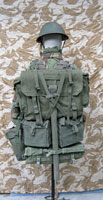
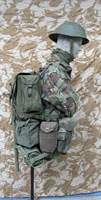 1958 Pattern early Marching Order with Lightweight Pick and Respirator haversack, over '71 Pattern Combat smock. (Note that the Yoke and Pouches, rear are 2nd issue). From the James Harriss Collection, photos © James Harriss 2012.
1958 Pattern early Marching Order with Lightweight Pick and Respirator haversack, over '71 Pattern Combat smock. (Note that the Yoke and Pouches, rear are 2nd issue). From the James Harriss Collection, photos © James Harriss 2012.
Distinguishing features:
1) Ammunition pouches are for 2 magazines and have an internal lift strap. C-hooks attach Pouches at 90° to Belt.
2) Water bottle carrier has a turn-stud closure.
3) Cape carrier - There is a strap and buckle fitting on the Pick head carrier- early versions have a black sheradised pressed brass edging on the strap end.
4) Respirator haversack is ancillary and does not attach to the webbing.
5) Generally made from a much coarser weave and heavier weight of canvas than later examples.
1958 Pattern Web Equipment: Fighting Order - (Mid-period Issue)
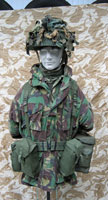
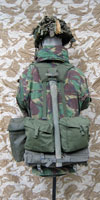 1958 PatternFighting Order, mid-period (commonest variety), over Arctic smock, 'Mao' suit, '71 Smock, 'woolypully', KF Shirt (Falklands impression). The helmet is a Falkland War veteran. From the James Harriss Collection, photos © James Harriss 2012.
1958 PatternFighting Order, mid-period (commonest variety), over Arctic smock, 'Mao' suit, '71 Smock, 'woolypully', KF Shirt (Falklands impression). The helmet is a Falkland War veteran. From the James Harriss Collection, photos © James Harriss 2012.
Distinguishing features:
1) Ammunition pouches for 3 magazines/ utility. C-hook attachment is angled at approx 80° to Belt, thus sweeping the lower part of the Pouch to the rear for ergonomic reasons.
2) Water bottle carrier has a strap and buckle closure.
3) Cape carrier - Pick head carrier strap has a green anodised, square, folded aluminium terminus with a central, narrow flanged, hollow rivet (as per Large pack).
4) Gas mask haversack is made from Butyl-Nylon and attaches to the Belt with a wide loop, or can be carried on its integral shoulder strap. Originally part of the 1972 Pattern Trials equipment, it was one of the few items retained and added to I.E., 1958 Pattern.
1958 Pattern Web Equipment - (Late Issue)
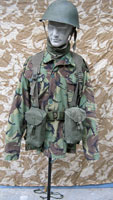

 1958 Pattern, late issue. From the James Harriss Collection, photos © James Harriss 2012.
1958 Pattern, late issue. From the James Harriss Collection, photos © James Harriss 2012.
Distinguishing features:
1) These "clean" 4th issue Ammunition pouches were made without the pocket for the ENERGA grenade launcher (on right) and without the Bayonet loops on left.
2) Belt, also known as 'Working belt' is now heavy woven nylon with a pair of rectangular steel loops (1990 style) on lower rear for the Cape carrier to attach to. Blackened brass buckle at front, with brass sliders and C-hook length adjustment (1937 style).
(Not Shown) the Yoke has had the Spigot Carrier for the Lightweight Shovel cut off. This was a very common 'field' adaptation, as it got in the way of wearing a Bergen rucksack.
Associated but not part of Pattern 1958:
1) Nylon First field dressing pouch - (1972 style).
2) Night vision goggle pouch, Butyl-Nylon with plastic 1972 style D-rings (for shoulder strap) with 1958-style Keyways for attachment to the Belt.
1958 Pattern Web Equipment - Ancillary and Associated Equipment (Early to Mid-period Issue)
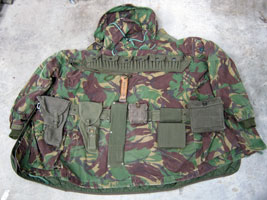 Some of these items are included in I.E., Patt. 1958, whilst others are N.P.E. but associated with Patt. '58. From the James Harriss Collection, photos © James Harriss 2012.
Some of these items are included in I.E., Patt. 1958, whilst others are N.P.E. but associated with Patt. '58. From the James Harriss Collection, photos © James Harriss 2012.
Top: Belt, primers.
Below, left to right:
1) 1958 Pattern Holster, for the 9mm Browning Hi-Power (replaced item 2).
2) Canadian 1951 Pattern Holster, for the 9mm Browning Hi-Power. Britain bought thousands of these for use with Patt. '44 and Patt. '58 webbing.
3) Golok in Sheath. Originally issued with (but not part of) W.E., Patt. '44, these replaced the earlier Machet, 18-inch, and its Sheath, and were used with both Patt. '44 and '58.
4) 1958 Pattern Compass pouch.
5) CN 8465-99-135-7280 Socket, rifle supporting (made and QMSed to Ulster, but never actually issued to troops).
6) 1958 Pattern Binocular case.
James Harris 2012
1958 Pattern Web Equipment - Early Period
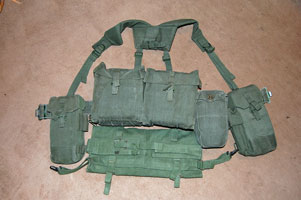
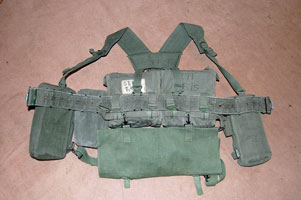 This assembly brings together the 1st Issues of the various components. When first introduced, there was no Carrier for the Canteen, so the Patt. ’44 Carrier and Bottle were in use. This view is therefore representative of an assembly around 1963, but by this time the 2nd Issue Ammunition pouches had been introduced, although the 1st Issue can still be seen in photographs. The 1st Issue Yoke had no loops to retain the shoulder straps of the Pack. The 1st Issue Cape carrier has a crimped, U.S. style alloy tip fitted to the buckled connection. This strap closed the open side of the pocket that held the head of the Lightweight pick. The 1st Issue Ammunition pouches had a narrow cross-section and a shaped box-lid, with fully stiffened sides. The “C” clips were not angled, so the Pouches hung perpendicular to the Waist belt. The adjustable side straps on the Cape carrier attached, again with levered snap hooks, to dees on the rear outside edges of the Ammunition pouches. Not visible here are the sides of the box-lidded Rear pouches. These were stiffened along their diagonal edges.
This assembly brings together the 1st Issues of the various components. When first introduced, there was no Carrier for the Canteen, so the Patt. ’44 Carrier and Bottle were in use. This view is therefore representative of an assembly around 1963, but by this time the 2nd Issue Ammunition pouches had been introduced, although the 1st Issue can still be seen in photographs. The 1st Issue Yoke had no loops to retain the shoulder straps of the Pack. The 1st Issue Cape carrier has a crimped, U.S. style alloy tip fitted to the buckled connection. This strap closed the open side of the pocket that held the head of the Lightweight pick. The 1st Issue Ammunition pouches had a narrow cross-section and a shaped box-lid, with fully stiffened sides. The “C” clips were not angled, so the Pouches hung perpendicular to the Waist belt. The adjustable side straps on the Cape carrier attached, again with levered snap hooks, to dees on the rear outside edges of the Ammunition pouches. Not visible here are the sides of the box-lidded Rear pouches. These were stiffened along their diagonal edges.
The attachment of the 1st Issue Rear pouches is clearly shown and achieved by using the old-fashioned keyways in an entirely new way. Where they had once been used to steady items, by interaction with a mushroom stud, the keyhole shaped hole was now placed over a staple. Long, steel stiffened tabs, attached permanently to the Pouches was now used, were inserted thro the staples. A section of these straps was doubled and stitched around a “T” formed in wire, which served as the pull tab to release the straps. As can be seen, the Rear pouches extend well above the Belt and could fall away from the wearer’s back, even when filled. The levered snap hooks on the Cape carrier can be seen attached to small dees on chapes, which are stitched to the lower outside of the Belt. From the Rog Dennis Collection, photos © Rog Dennis 2012.
1958 Pattern Web Equipment - Mid Period
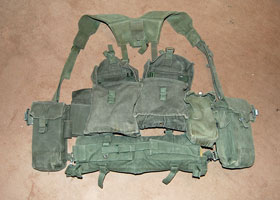
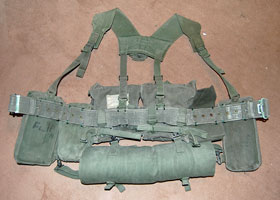 This assembled set comprises those items that are 2nd Issue, these being the Ammunition- and Rear pouches, other items being un-changed.
This assembled set comprises those items that are 2nd Issue, these being the Ammunition- and Rear pouches, other items being un-changed.
The 2nd Issue Rear pouches had the same shape box-lids, but the stiffening strips were deleted. The lids are shown open, revealing the long fairleads stitched on the underside of the lid of both 1st and 2nd Issue Pouches. The folded 1st Issue Straps, utility were stored in these, as here, when not in use.
The Pouches, ammunition, left and right were simply described as “Modified” in COSAs. As Patt. ’58 W.E. had all been introduced at stated Mark 1 status, these should, by rights, have been worthy of Mark 2 status. In the event Mark 2 was the all-nylon experimental set of the 1970s. The Ammunition pouches still hung perpendicular to the belt and were of the same cross-section. However, the stiffened and shaped lids of the 1st issue were completely abandoned. In their place, somewhat abbreviated and un-stiffened box lids were substituted.
The inside view shows that the 2nd Issue Rear pouches were still subject to the same design flaw, in that they fell away from the wearer’s body. Inadvertently (mea culpa!) the 2nd keyway from the left has not been fastened to its staple.
Between the Rear pouches and the left Ammunition pouch is an item that was not a general issue and which was not designated as “Patt. ’58 W.E.”. This was the Socket, rifle supporting, which was intended for use in Northern Ireland, for troops to support the butt of their 7.62 mm SLR. In COSAs, this was qualified as MoD Controlled and was rarely seen. It was sufficient to hold the rifle, with its butt supported on the right hand Ammunition pouch. It was fitted with “C” hooks on the reverse, connected here to the Belt, but above this was a full-width fairlead, which allowed the socket to be worn below the Belt. From the Rog Dennis Collection, photos © Rog Dennis 2012.
1958 Pattern Web Equipment - Late Period

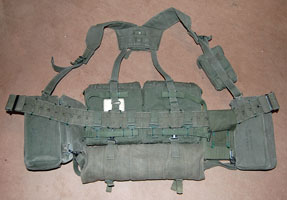 These two assembled views show the final stages of development, although there would be one more change after these. It represents the items manufactured for the greater part of the service life of Patt. ’58.
These two assembled views show the final stages of development, although there would be one more change after these. It represents the items manufactured for the greater part of the service life of Patt. ’58.
In reference to these six assembled views, the various components are termed for convenience as 1st, 2nd and 3rd issue. Itshould be noted that, at no stage down the centuries, did the Army immediately adopt new issues of equipment. LoCs merely informed of what was available and they were not an invitation to indent for these new issues, if serviceable items were already on charge. Those who would ascribe an introduction date for equipment, derived from LoCs - for any Pattern - should do so with extreme caution. The various issues of Patt. ’58 were no exception and items worn were of mixed issues, until there were no further stocks, or until condemned as worn-out.
Described simply as Pouches, ammunition, large, the 3rd Issue pouches were never graced with a Mark 3 nomenclature. The cross-sectional area was greatly enlarged and the belt hooks were, at last, patched on an angle, throwing the Pouches to the side. This enabled soldiers to actually sit more comfortably in such as armoured personnel carriers. Pretty obvious, really, but it took the Army a while before the penny (an Old Penny, not these new fangled Pees!) dropped. The Socket, rifle supporting – NOT part of Patt. ’58, per se, is shown here in its dropped position, using the broad fairlead. This position was normally occupied by the far large Haversack, respirator, S6. The already crammed-together pouches allowed little room for this, unless the soldier was of more generous girth – which young soldiers rarely were! The all-too-tight Carrier, water canteen (Why? The British Army speak English-English) was pointlessly modified to an 2nd Issue. It was still too tight, either for insertion or extraction of the plastic bottle and the easy-to-use turn-button closure was now a fiddly strap and buckle. Strange are the way… Perhaps the turn-button manufacturer went out of business, or simply decided to cease production.
Another item shown here is a Medical pouch, whose nomenclature has yet to be determined. It could only be worn threaded on the Yoke straps. This also had a box-lid and turn-button closure, looking like a “square” mini Water bottle carrier. Its contents are unknown and no contemporary photograph of it in use has been noted.
The Pouches, rear were also at long last modified to be a practical proposition. The 3rd Issue had an extra pair of staples, mounted centrally near the top of the Pouch back. An extra strap was stitched at right-angles to the release strap and this was simply bent round to pass horizontally through the staples, trapping the rear Yoke straps between them. This modification secured the pouches to the Yoke straps, obviating the previous tendency to sag, however well packed they were. The lower staples were increased to three each side, the third one being fitted close to the centre-line staples, on each Pouch back. The reason for this is not clear, as the keyway only aligns with the original link position.
The 2nd Issue Carrier, cape changed only subtly, the crimped tip on the E.T. Head pocket being changed to an eyeleted alloy tip. The two-position closure of the wrap-around Carrier was modified to have three sets of staples, allowing for larger loads, as N.B.C. clothing often had to be crammed in with the Groundsheet cape, or later nylon Poncho. Not visible here are the Utility straps stored inside the Rear pouches. These also changed from crimped to eyeleted tips.
The final change was to a 2nd Issue Yoke, which now had transverse loops added to the rear part of padded flares. This was to better locate the shoulder straps of the Pack. There was one further change, which only emerged during the writing of this account. This was a fourth Issue of the Ammunition pouches. These were the 3rd Issue, but manufactured without the pocket for the Energa grenade launcher on the right-hand Pouch. The launcher had long since disappeared, being replaced by more modern and self-contained weapons. However, the pocket had proved very useful for keeping the Mess Irons in!! The left-hand Pouch also lost its bayonet loops, presumably as a result of switching from the S.L.R. to the S.A. 80. The bayonet for the latter came in a sheath fitted with a Fastex harpoon clip, which in turn fitted into a Frog, so called, that was actually an over-scabbard. From the Rog Dennis Collection, photos © Rog Dennis 2012.
Rog Dennis 2012